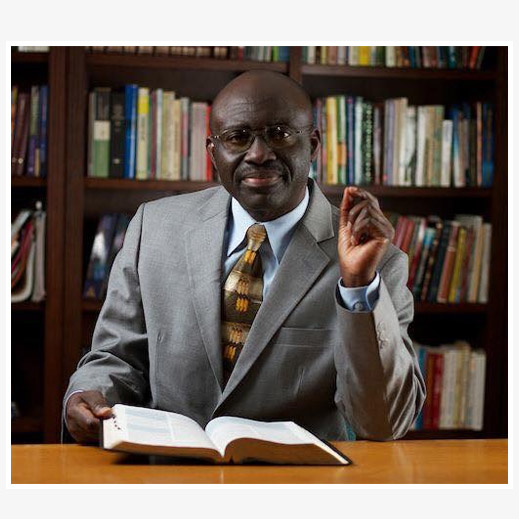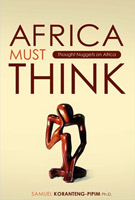2. The Bible and the Ministry of Women - Part 3
[This article is excerpted from the author’s book Must We Be Silent?]
By
Samuel Koranteng-Pipim, PhD
Director, Public Campus Ministries, Michigan Conference
Introduction
Among other things, in parts 1 and 2 of this discussion, we challenged the questionable claims by proponents of women’s ordination that there were women priests in the Old Testament and women apostles in the New Testament. In this final installment, we shall examine another innovative interpretation by pro-ordination scholars within our church—namely, the claim that Phoebe was a “female minister” and that there might have been other “women ministers” in the New Testament.
Phoebe: A “Female Minister”?
In Romans 16:1, 2, the apostle Paul writes: “I commend unto you Ph[o]ebe our sister, which is a servant [diakonos] of the church which is at Cenchrea: That ye receive her in the Lord, as becometh saints, and that ye assist her in whatsoever business she hath need of you: for she hath been a succorer of many, and of myself also” (KJV).
Based on the above description of Phoebe as a diakonos (“servant,” KJV, NIV, NASB; or “deaconess,” RSV), one of the authors of the pro-ordination book Women in Ministry claims that Phoebe functioned “as Paul’s emissary, as did Titus and Timothy,” and that her designation as diakonos “does not imply the modern ‘deaconess’ but rather the same position as that of the church leaders designated in 1 Timothy 3:8-10.”[1] Another author maintains that Phoebe is an example of New Testament “women in church leadership-headship roles.”[2]
These writers do not offer any Biblical proof for their assertions. They build their cases on the “able” studies provided by another Women in Ministry writer who concludes that Phoebe was a “female minister,” and that “if there could be one female minister there could as well be many.”[3]
However, a careful study of the evidence presented by the book’s leading proponent of the “female minister” theory indicates that it involves a convoluted handling of the Biblical data and that it contradicts Ellen White’s understanding. The following points capture the essential thrust of the arguments in Women in Ministry:
(1) The term diakonos, used for Phoebe in Romans 16:1, comes from the same root word (diakonein) used for the appointive ministry of the seven men in Acts 6.[4]
(2) But this office of diakonos assigned to the seven men of Acts 6 is not that of deacons as “has often been assumed,” even in Ellen G. White’s book The Acts of the Apostles! [5]
(3) Instead, the kind of work for which the seven men of Acts were appointed is the same as “elder,” the only appointive ministry originally known in the apostolic church. [6]
(4) Only later did the one appointive ministry of diakonos (now redefined by the author to mean “elder” or “minister”) divide into two levels of “elder” and “deacon.” [7] The alleged later “distinction between deacon and elder/bishop is hardened in the Pastoral Epistles, especially in 1 Timothy 3:1-13.” [8]
(5) Phoebe occupied “the same position as the deacons of 1 Timothy 3,” which our author claims was originally the same office as that of elder, or possibly that of apostle. [9]
(6) Therefore, the designation of Phoebe as diakonos in Romans 16:1 “proves incontrovertibly that the early church had female diakonia”—i.e., female ministers. And “if there could be one female minister [Phoebe] there could as well be many.” [10]
In responding to this interpretation, we will briefly discuss the meaning of the term diakonos. We will note how Ellen G. White understood the function of the seven men of Acts 6 and what bearing it has on the “female minister” theory.
Meaning of “Diakonos.” In the New Testament the term diakonos, like the related terms diakonia and diakoneo, has both a broad and a narrow meaning. In its broad sense it conveys the idea of a ministry or service carried out on behalf of the church. Thus, services like preparation of a meal (Luke 10:40), serving a meal (Luke 22:27), providing financial and material support (Luke 8:1-3), the employment of any spiritual gift (1 Corinthians 12:5; 1 Peter 4:10), doing the work of a deacon by taking care of the needy (Acts 6:1-4), and providing spiritual oversight and leadership for the churches by serving as an elder (1 Timothy 4:6) or apostle (Acts 1:25) are all termed ministry (diakonia). Because in this broad usage anything a person does to advance the work of the church is a ministry, the one who labors in this manner is a minister or servant (diakonos) of the Lord. [11]
In its narrow and technical usage, diakonos refers to the office of a deacon that among other things can be occupied by only one who is a “husband of one wife” (1 Timothy 3:8-13; Philippians 1:1). This deacon office, first occupied by the seven men of Acts 6, involved ministering to the poor, needy, and sick. But “although deacons were to care for the temporal affairs of the church, they were also to be actively involved in evangelistic work (Acts 6:8; 8:5-13, 26-40).” [12]
Whether we apply the broad meaning or the narrow one, calling Phoebe a diakonos does not prove she was an apostle or a female minister. [13] Indeed, Paul explains why he calls her a deacon—because she is a “succorer [helper] of many” (Romans 16:2). As for the seven deacons, they certainly were not apostles; they were elected specifically to do work the apostles felt unable to do at that time. Until recently, Seventh-day Adventists have upheld the view that Romans 16:1, 2 refers to Phoebe’s valuable ministry of care and hospitality for church members. To change from this well-established view surely needs better evidence than what Women in Ministry provides. [14]
Ellen G. White presents Phoebe not as a “female minister,” but rather as an example of how we should “care for the interests of our brethren and sisters.” Referring to Romans 16:1, 2, she states, “Ph[o]ebe entertained the apostle, and she was in a marked manner an entertainer of strangers who needed care. Her example should be followed by the churches of today” (Testimonies for the Church, vol. 6, pp. 343, 344).
Ellen White on the Seven Men of Acts 6. The “female minister” theory proposal in Women in Ministry can only be sustained by proving that the seven men of Acts 6 were elders and not deacons. The leading proponent of this theory is wrong when he argues that because the title of chapter 9 (“The Seven Deacons”) in Ellen White’s The Acts of the Apostles may be the work of editors, it therefore does not show that she believed the seven men of Acts 6 were deacons. [15]
During her lifetime, all editorial work on her books was submitted to Ellen G. White for approval before a book was published. We can safely conclude that she approved the chapter heading in The Acts of the Apostles, chapter 9. Also, contrary to what Women in Ministry says, in that very chapter (p. 91) Mrs. White does indeed refer to the seven men as deacons (not ministers or elders). Furthermore, elsewhere in the book she describes Philip as “one of the seven deacons” (p. 106); she also refers to Stephen as “the foremost of the seven deacons” (Lift Him Up, p. 104). To claim that Acts 6 is describing seven elders and not seven deacons is to interpret the Bible differently from the way Ellen White interprets it. And to assert, as our author does, that Mrs. White describes these men only as officers and not deacons in the text is simply wrong.
The History of the Appointive Ministry. Is there a Biblical basis on which to speculate that the original appointive ministry in the New Testament church was that of elder, and that this office was later divided into two levels (elders and deacons) so that in the Pastoral Epistles the distinction between the two was “hardened”?
As Women in Ministry notes, the first leaders of the church were the twelve apostles specially chosen by Christ Himself (Matthew 10:1-4; Mark 3:13-19; Luke 6:12-16). Like the twelve patriarchs or the leaders of the tribes of Israel, these twelve male apostles constituted the original ministry. We find that to them was entrusted the responsibility of general spiritual leadership of the churches, serving as overseers (episkope, “office,” a cognate of episkopos [bishop or elder], is applied to the apostolate in Acts 1:20) and ministering to believers’ needs (diakonia, “ministry,” is their work in Acts 1:25; cf. the cognate diakonos, “deacon,” “one who ministers”).
But as the Gospel work prospered, it was practically impossible for the apostles alone to perform all the functions of spiritual leadership and at the same time minister to members’ physical needs. Led by the Holy Spirit, the original ministry of the twelve apostles was expanded to include chosen deacons (diakonos) and elders (presbyteros) or bishops/overseers (episkopos). [16]
Were the offices of elders and deacons really one office originally, later split into those two? Women in Ministry offers slim evidence for this, which we will merely comment on here.[17]
(1) According to the leading proponent of the “female minister” theory, “The kind of work for which the seven were appointed in Acts 6 is said to be done by the elders in Acts 11:30.” But the Bible text does not say this. It records only that the relief money for Judea was delivered to the elders, not that the elders personally conducted the distribution, as the seven did in Acts 6. As the representatives of the believers, the elders would be the appropriate ones to receive the gifts from the distant churches, regardless of who did the actual distribution.
(2) The argument that the elders’ method of appointment “resembles somewhat” the method for the seven appointed in Acts 6 is a weak basis for claiming that they were the same. Such partial resemblance does not indicate that the offices were identical.
(3) Finally, our author argues that because Acts 15 mentions only the offices of apostle and elder in Jerusalem, the office of deacon was not in place by the time of the Jerusalem Council. But this is an argument from silence regarding deacons. The kinds of decisions spoken of in Acts 15 may well have been considered the responsibility of the apostles and elders, and not the deacons, to make.
The three points above, together with the denial that Acts 6 instituted the office of deacon, are the bases upon which our Women in Ministry scholar constructs his theoretical history of the appointive ministry. But as we have shown, it does not follow from these points that “we must conclude” that the church had only one office of elder at the early stage and that this one office was later split into two (elder and deacon). The New Testament writers and Ellen G. White affirm that the apostles instituted the office of deacon at a very early stage in the history of the Christian church. And each of the deacons mentioned in Acts 6 was a male.
Inasmuch as the New Testament offices of apostles, elders, and deacons were a continuation and extension of the headship and leadership roles instituted at Creation (and exercised by male priests in the Old Testament, and male apostles at the time of Christ), the spiritual qualification for these offices included gender specifications (“the husband of one wife,” 1 Timothy 3:2, 12; Titus 1:6). Though our author claims that this gender specification actually was generic, [18] such a claim overlooks the fact that in two passages in Acts where qualifications are set forth, one for apostle (Acts 1:21) and the other for the office of deacon under consideration (Acts 6:3), the text uses the Greek word aner, a male, instead of the generic anthropos, a person. The term anthropos could have been used here without grammatical difficulty if a person of either gender had been intended.
In light of the above facts from Scripture, the speculations about Phoebe in Women in Ministry cannot be sustained. Contrary to the authors’ claims, Phoebe, being a “sister,” could not have occupied “the same position as that of the church leaders designated in 1 Timothy 3:8-10.” Neither could she have been an example of New Testament “women in church leadership-headship roles.”
Phoebe’s Commendation: A Ministerial Credential? The authors of Women in Ministry argue that Paul’s commendation of Phoebe (as “a servant of the church”) and his request on her behalf (“receive her in the Lord, as becometh saints”) imply that Phoebe functioned “as Paul’s emissary, as did Titus and Timothy,” [19] or that this commendation is a kind of ministerial credential for Phoebe. Writes the leading proponent of the “female minister” theory:
Paul requests that she [Phoebe] be given the same kind of reception as his other representatives, the same kind of support and respect that Paul enjoins for Titus and the other apostoloi [apostles] (Titus in 2 Corinthians 8:24; Timothy in 1 Corinthians 16:10). Such a letter of commendation was the only kind of credential that the early church could offer. If there could be one female minister there could as well be many. [20]
The argument suffers from at least two serious interpretive fallacies. First, it disregards the context, namely Paul’s commendations of and personal greetings to several individuals in Romans 16. Second, it is an instance of a procedure known technically as “illegitimate totality transfer,” which supposes that the meaning of a word (e.g. diakonos) or expression (e.g., Paul’s commendation) in a given context is much broader than the context allows. In this way the sense of a word (e.g., diakonos) or expression (commendation or request) and its reference (particular individuals, e.g., Phoebe, Titus, Timothy) are linked in an unwarranted fashion, giving the impression that the given word or expression means the same thing in any conceivable context.
Context really is the key for understanding the meaning of a word. While diakonos was indeed a church office, the most common meaning of the word was servant. When the apostles call themselves diakonos, the translation as minister misses the point—they were specifying that, like Christ, they led by serving. They were not identifying themselves as deacons or ministers. Any reference to the office of deacon can be determined only from the context. The Bible’s stated fact of Phoebe’s devoted service to the church, making herself the servant of all, does not mean that she held the office of deacon. The context does not suggest that Paul is talking about a church office.
A fair reading of the New Testament shows all church office names were derived from common functions. Serving, then, did not make one a deacon; being elderly did not make one an elder; being sent (apostolos) did not make one an apostle like the Twelve; and being an aggelos (messenger) did not make one an angel, though the Greek words are the same. The context is crucial to a proper understanding of a word’s meaning.
In light of our discussion in the preceding pages, the assertion that Phoebe functioned as “Paul’s emissary, as did Titus and Timothy” and that Paul’s letter was a “kind of credential” for one of many “female ministers” can be dismissed as a convoluted interpretation. On the contrary, when Paul commended Phoebe as “a servant [diakonos] of the church . . . [and] succorer of many, and of myself also” (Romans 16:1-2), he was speaking of her valuable personal ministry to members of the church as well as to himself.
We must conclude that Phoebe was not a female minister. Hence there is no basis for the statement, “If there could be one female minister there could as well be many.” From the evidence given us in the New Testament, there weren’t any. [21]
Conclusion
This article has examined some of the areas in which Seventh-day Adventists should carefully examine the assertions Women in Ministry makes regarding women serving as priests in the Old Testament and as apostles and ministers in the New. The scholars of the pro-ordination volume tried very hard to explain away the lack of Biblical precedence for ordaining women as elders or pastors. Their bold effort of attempting to come up with their flashing new light about women priests, women apostles, and women ministers may be innovative. But the assumptions underlying the theories are incorrect, and therefore so are its conclusions about ordaining women as elders and pastors today.
Endnotes
[1] Jo Ann Davidson, “Women in Scripture,” WIM, p. 177.
[2] Richard M. Davidson, “Headship, Submission, and Equality in Scripture,” WIM, p. 282; cf. Vyhmeister, “Epilogue,” WIM, p. 434.
[3] Robert M. Johnston, “Shapes of Ministry in the New Testament and Early Church,” WIM, p. 51. Jo Ann Davidson points readers to Robert Johnston’s work in Women in Ministry, where the latter “studies this significant detail” about Phoebe’s role as a diakonos (Jo Ann Davidson, p. 185, n. 78). Similarly, Richard M. Davidson writes: “Examples of women in church leadership/headship roles have been ably presented in Robert Johnston’s and Jo Ann Davidson’s chapters (3 and 9). Deacons included the woman Phoebe (Romans 16:1) and probably the women referred to in 1 Timothy 3:11” (Richard M. Davidson, WIM, p. 282).
[4] Robert M. Johnston argues that the appointive ministry “could be called either diakonos (suggested by diakonein in Acts 6:2), a word describing function, or presbyteros, a word describing dignity” (Johnston, “Shapes of Ministry in the New Testament and Early Church,” WIM, p. 49).
[5] Johnston is aware that the office of the seven men in Acts 6 is referred to as “deacon” in the chapter heading of Ellen G. White’s The Acts of the Apostles (chapter 9 of that book is titled “The Seven Deacons,” pp. 87-96). But he counters: “It is to be noted, however, that the chapter titles are mostly the work of the editors. The term ‘deacon’ does not occur in the text itself. Mrs. White simply calls them ‘officers’ (p. 89).” See Johnston, “Shapes of Ministry in the New Testament and Early Church,” WIM, pp. 49, 57, n. 19. Note, however, that in The Acts of the Apostles, pp. 91, 106, Ellen G. White does refer to the seven as “deacons.”
[6] Johnston argues that “at least in the earliest period, what can be said of ‘deacon’ also applies to ‘elder.’ Both were ministries which in the beginning were one, and they likely remained one in many places for several decades. Even in the Pastoral Epistles, Timothy is called diakonos (which the RSV translates ‘minister’) in 1 Timothy 4:6, though he had a charismatic gift that was somehow associated with prophetic designation and the laying on of hands (1:18, 4:14)” (Johnston, WIM, p. 51).
[7] Johnston concludes: “To begin with there was only one appointive ministry that could be called either diakonos (suggested by diakonein in Acts 6:2), a word describing function, or presbyteros [elder], a word describing dignity. Only later did this one ministry divide into two levels, and the two terms came to be used to designate the two levels of ministry” (Johnston, “Shapes of Ministry in the New Testament and Early Church,” WIM, p. 49). Explaining the basis of his conclusion, Johnston writes: “The kind of work for which the seven were appointed in Acts 6 is said to be done by the elders in Acts 11:30. Their method of appointment in the churches, reported in 14:23, resembles somewhat that of Acts 6. In Acts 15 we hear of only two offices in Jerusalem, those of apostle and elder. We must conclude that the church at this early stage knew of only one appointive ministry, which Luke designated ‘elder’” (ibid., p. 49).
[8] Ibid., p. 50.
[9] Ibid., p. 51. Our author reasons this way: “Paul requests that she [Phoebe] be given the same kind of reception as his other representatives, the same kind of support and respect that Paul enjoins for Titus and the other apostoloi [apostles] (Titus in 2 Corinthians 8:24; Timothy in 1 Corinthians 16:10). Such a letter of commendation was the only kind of credential that the early church could offer. If there could be one female minister there could as well be many” (Johnston, p. 51; cf. ibid., p. 49).
[10] Ibid., pp. 50, 51. Believing that he has “proved” that Phoebe was a “female minister” and speculating that there “could as well be many” female ministers, this scholar transforms his speculations into the following assertion of certainty: “That there were women in the appointive ministry implies something about that ministry that logically should have remained true even after it began to be differentiated into two and then three levels, just as the qualities of a piece of clay remain the same even when it is divided in two. But at some unknown point in history it ceased to be true, and women were squeezed out, at least from certain levels” (Johnston, WIM, p. 52).
[11] Cf. Matthew 20:26; 23:11; Mark 9:35; 10:43; John 12:26; Romans 13:4; 15:8; 1 Corinthians 3:5; 2 Corinthians 3:6; 6:4; 11:23; Galatians 2:17; Ephesians 3:7; 6:21; Colossians 1:23, 25; 4:7.
[12] Seventh-day Adventists Believe . . . : A Biblical Exposition of 27 Fundamental Doctrines (Silver Spring, Md.: Ministerial Association, 1988), p. 148.
[13] The question confronting Bible students is this: Since in the Greek, the word diakonos can be either male or female in gender, depending on the context, when Paul referred to Phoebe as diakonos, was he using this term in the broad and general sense to suggest Phoebes activity of caring for the needy of the church (she was a “succorer of many” [Romans 16:2])? Or was the apostle using the term diakonos in the narrow and technical sense to suggest that Phoebe held the male office of deacon (1 Timothy 3:8-13), the same position held by the seven men of Acts 6?
[14] Because she is described as a “sister” (Romans 16:1), she could not have served in the male office of a “deacon” without contradicting the gender requirement in 1 Timothy 3:12 (a deacon must be the “husband of one wife”). Her ministry as “succorer” (KJV) or “helper” (RSV) (i.e., her “great help to many people” [NIV]), however, parallels what we designate today as the position of “deaconess.” By describing Phoebe as a diakonos, Paul was simply speaking of her valuable ministry to church members as well as to himself. One respected scholar has captured the Adventist understanding: “Though the word for ‘servant’ [diakonos] is the same as is used for [the office of] deacon . . . it is also used to denote the person performing any type of ministry. If Phoebe ministered to the saints, as is evident from [Romans 16] verse 2, then she would be a servant of the church and there is neither need nor warrant to suppose that she occupied or exercised what amounted to an ecclesiastical office comparable to that of the diaconate. The services performed were similar to those devolving upon deacons. Their ministry is one of mercy to the poor, the sick, and the desolate. This is an area in which women likewise exercise their functions and graces. But there is no more warrant to posit an office than in the case of the widows who, prior to their becoming the charge of the church, must have borne the features mentioned in 1 Timothy 5:9, 10.” See John Murray, The Epistle to the Romans, 2 vols., The New International Commentary on the New Testament (Grand Rapids: Eerdmans, 1965), vol. 2, p. 226. Even if (for the sake of argument) we assume that the term diakonos in Romans 16:1 reflects its narrow and technical usage (i.e., to the male office of “deacon”) and not its broad and general usage (i.e., the work of “ministry” on behalf of the church), the office of deacon is not the same as that of a “church leader”—either as elder or apostle, as is the case with Titus and Timothy. The authors of Women in Ministry who seek to discover an example of “women in church leadership/headship roles” in Romans 16:1 require the use of very powerful egalitarian lenses.
[15] Johnston, “Ministry in the New Testament,” WIM, p. 57, n. 19.
[16] According to the Bible, (1) those who are permitted to perform the oversight-leadership functions of the ministerial office are elders or pastors; and (2) the New Testament makes no essential distinction between the two offices. The Greek terms for elder or presbyter (presbyteros) and overseer or bishop (episkopos) are used interchangeably in the New Testament (Acts 20:17, 28; Titus 1:5-7; 1 Peter 5:1-3). The same qualifications are required for both (1 Timothy 3:1-7; Titus 1:5-9). Both perform the same work of shepherding the flock (Acts 20:17, 28; 1 Peter 5:1-4; 1 Thessalonians 5:12). Thus, we may conclude that since presbyters (elders) and bishops (overseers) are known by the same names and are required to possess the same qualifications, and since they do actually discharge the same oversight duties, the two terms refer to the same office of shepherding the flock. The book of 1 Peter brings all the terms together: pastor (shepherd), elder (presbyter), and bishop (overseer). “For ye were as sheep going astray; but are now returned unto the Shepherd (poimen, pastor) and Bishop (episkopos, overseer) of your souls” (1 Peter 2:25). “The elders (presbyteros) which are among you I exhort, who am also an elder . . . : Feed (poimano, to tend as a shepherd) the flock of God, taking the oversight (episkopeo) thereof. . . . And when the Chief Shepherd (archipoimen) shall appear, ye shall receive a crown of glory that fadeth not away” (1 Peter 5:1-4). The elders are commissioned to stand as overseers, functioning as pastors/shepherds to the flock.
[17] Johnston, “Ministry in the New Testament,” WIM, p. 49.
[18] .Johnston, “Shapes of Ministry in the New Testament and Early Church,” WIM, pp. 50, 51.
[19] Jo Ann Davidson, “Women in Scripture,” WIM, p. 177.
[20] Johnston, “Shapes of Ministry in the New Testament and Early Church,” WIM, p. 51.
[21] Seventh-day Adventists Believe . . . , p. 150, n. 10 correctly observes that because in New Testament times the term diakonos had a broad meaning, “’it was still employed to describe all who served the church in any capacity. Paul, though an apostle, frequently described himself (see 1 Corinthians 3:5; 2 Corinthians 3:6; 6:4; 11:23; Ephesians 3:7; Colossians 1:23) and Timothy . . . (see 1 Timothy 4:6), as diakonoi (plural of diakonos).’ (Seventh-day Adventist Bible Commentary, rev. ed., vol. 7, p. 300). In these instances it has been translated as ‘ministers’ or ‘servants’ instead of ‘deacons.’” See also P. Gerard Damsteegt’s detailed critique of the “female ministry” hypothesis in Prove All Things, pp. 129-153.









